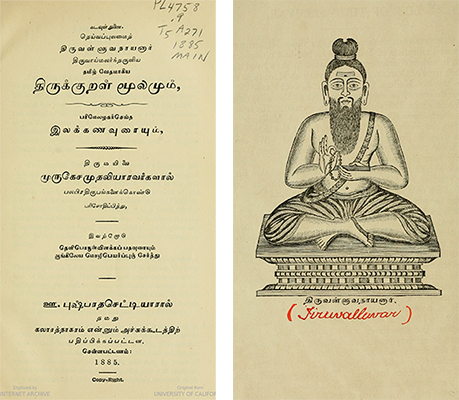6 Tamil

It would not be an exaggeration to say that the Tirukkural holds the same status in Tamil culture that Confucius’s Analects hold in the Chinese and Sadi’s Gulistan holds in the Persian cultures respectively. Not only is the Tirukkural considered a masterpiece of literature but is also seen to embody the essence of Tamil ethics, virtue, and morality. A copy of the text can be found in nearly every Tamil home and verses from it are frequently quoted. In fact, it is so revered that one can take an oath on it in Tamil courts of law.
Despite such reverence, very little is definitively known either about the work’s author or the context of its production. Traditionally, it is attributed to Tiruvalluvar. The prefix tiru in both Tiruvalluvar and Tirukkural is the Tamil equivalent of the Sanskrit sri and roughly means holy or sacred. Hence, the name of the reputed author is Valluvar. It is said that Tiruvalluvar, or Holy Valluvar, was a humble weaver who, despite his humble origins and implied lack of formal education, was so sagacious, pious, and holy that he perfectly captured the very essence of ethics, virtue, and morality, in fact the very essence of dharma, in short pithy poetic couplets that remain unsurpassed to this day.
Tiruvalluvar is generally believed to have lived in the 2nd century BCE, although there is no hard historical evidence for this and he might have lived any time between the 2nd century BCE and the 7th century CE. There is also no agreement on the place of his birth and exact religious affiliation. Nearly every major religion and sect in Tamil society has laid claim on him. Buddhists and Jains point to the similarity of Tiruvalluvar’s ethical teaching and the ethics of their respective traditions. Some Christians claim to see a Christian influence on him and declare him to be a disciple of St. Thomas the Apostle, who is traditionally held to be buried in Tamil Nadu. Even among Hindus there is no agreement on whether Tiruvalluvar was a Shaivite or Vaishnavite. Yet all appreciate his insights and their literary style.
The title of the work, Tirukkural, refers to this pithiness of the poetic couplets as kural literally means short, brief, concise or abbreviated. The work can thus be described as a set of poetic aphorisms. The meter used for the couplets is venpa, which is a very short meter. The text covers 133 topics each with 10 couplets dedicated to it giving a total of 1330 couplets. The topics are broadly related to three themes and thus divided into three sections. The first covers aram (virtue or dharma), the second deals with porul (wealth) and the last section is about inbam (love and enjoyment). These three sections cover the four main aims of human life as understood by Hindu sages. In Sanskrit they are called dharma (virtue, religious ethics), artha (wealth), kama (physical enjoyment), and moksha (salvation). The section on aram deals with both dharma and moksha, while the section on porul deals with artha, both at the individual and at the social and political level, and the section on inbam deals with kama.
In the traditions and legends related to Tiruvalluvar, another important person connected with his work is his wife Vasuki. Not only was she an ideal wife but was also wise and holy like her husband. She became a means and medium for many of the teachings about an ideal married life, relations between spouses, patience, and forbearance. It is through her that Tiruvalluvar was able to give the answer to the question of whether salvation can be achieved while being a married member of society or does one have to renounce all social, especially marital, relations.
Tirukkural was first translated into Latin by the Italian Jesuit missionary Constanzo Beschi in 1699. As interest in Tamil culture and the Tamil language grew, it was subsequently translated into a number of European languages including English. Among these is the translation featured here that includes commentaries by respected Brahim scholars.
Until recently, the University of California, Berkeley was the only university in the United States to have a chair in Tamil Studies. From the very beginning of the Department for South & Southeast Asian Studies Tamil was one of the primary languages offered by it. World-renowned scholars, like Murray Barnson Emeneau, made Cal famous for the study of Dravidian and Indian linguistics. In 1975 Prof. George Hart joined as the Professor of Tamil and remained the holder of the Tamil Chair until his retirement a few years ago. His wife Kausalya Hart was the Tamil language instructor on campus and together they wrote Tamil textbooks that are still widely used. Professor Hart played a key role in having the Indian government formally declare Tamil to be a classical language in 2004. Prof. Hart’s scholarly research on Tamil and Tamil literature earned him many awards and accolades including the Padma Shri, India’s third highest honor. Berkeley is set to continue its fine scholarly tradition in Tamil Studies as it looks forward to welcoming a new Tamil professor in a few months’ time. At the same time, Tamil language instruction continues to be provided by Dr. Bharathy Sankara Rajulu.
Contribution by Adnan Malik
Curator and Cataloger for the South Asia Collection
South/Southeast Asia Library
Title in English: The Kural of Tiruvalluvar
Authors: Tiruvalluvar; John Lazarus (trans.)
Imprint: Madras: W.P. Chettiar, 1885.
Edition: Unknown
Language: Tamil
Language Family: Dravidian
Source: HathiTrust Digital Library (UC Berkeley)
URL: https://catalog.hathitrust.org/Record/006747135
Other online editions:
- English translation from Project Madurai, Side-by-side Tamil/English translation from
http://thirukkural.gokulnath.com
Select Print editions at Berkeley:
- Tiruvalluvar, John Lazarus (trans.). The Kural of Tiruvalluvar. Madras: W.P. Chettiar, 1885.

